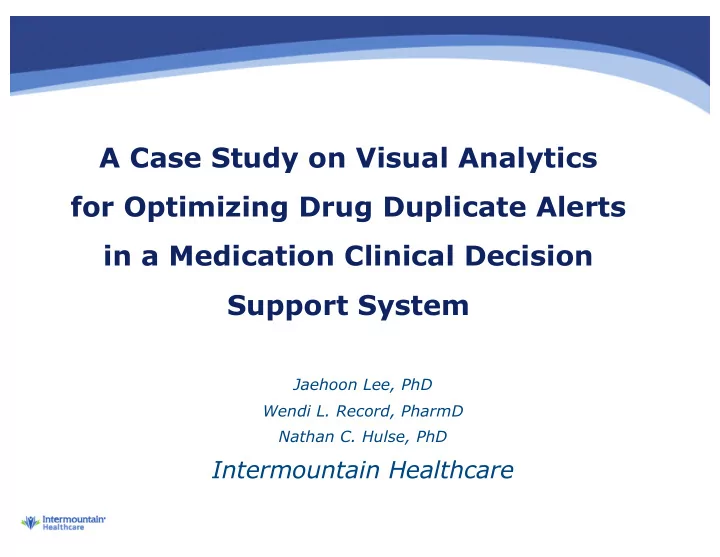

A Case Study on Visual Analytics for Optimizing Drug Duplicate Alerts in a Medication Clinical Decision Support System Jaehoon Lee, PhD Wendi L. Record, PharmD Nathan C. Hulse, PhD Intermountain Healthcare
Disclosure We do not have any conflict of interest to • report. We do not have fancy visualization in this • presentation. We only have bar chart and line chart.
mCDS: Medication Clinical Decision Support System Key components in modern electronic health record • (EHR) systems Specialized in preventing and reducing human errors • related to drug prescription Integrated with computerized physician order entry • (CPOE) Known to have a positive impact on preventing • adverse drug events in healthcare institutes
Alert fatigue mCDS are delivered to providers as an intervention to • recommend change or reconsider of their action, typically as a form of “ALERT” ALERT FATIGUE : apathy of providers against alerts • resulted by too many alerts Alert optimization: minimize the number of alerts • presented to users while maintaining or maximizing effectiveness
Alert effectiveness Quantitively measuring frequency of alerts changes a • provider’s behavior Overridden rate: how many alerts are overridden • (acknowledged or ignored) Interpreted differently by various clinical contexts on • how and why alerts are generated, clinical settings, whether an alert is accepted or overridden, and characteristics of providers seen by
Our approach Data-driven approach • Developed metrics representing different perspectives of • effectiveness Visual analytics • Human visual perception is the best tool for pattern detection • and decision making Statistical process monitoring • Automate data extraction to detect abnormality in real time •
mCDS alert dialog
mCDS alert dialog Triggering order: can be associated with multiple • orders already made for a patient (i.e. precondition order) at the time of ordering, An alert dialog may consist of multiple alert sections • for each represents association between a triggering order and precondition orders. A provider can choose to continue or remove a • triggering alert. Suppression: a function to block alerts depending on • specific conditions. Overridden reason: selecting from the list or manually • entering free text.
Duplicate alert To detect inappropriate duplication of therapeutic • groups or active ingredients and are estimated significant proportion of volumes in medication related alerts Hard to optimize duplicate alerts, as their nature is • related to clinical workflow or logistics processes, such as outpatients receiving prescriptions from different prescribers or early refill sue to holidays
Key metrics Alert dialog # of alert dialog seen by user • # of alert dialog with continued triggering order • # of alert dialog with removed triggering order • # of alert dialog with modification of at least one • precondition orders within 10 minutes Precondition orders # of alert generated in an alert dialog • # of alert overridden reason entered (either selected or • typed) # of alert suppressed by system • # of modification of precondition orders •
Effective metrics
Proof-of-concept implementation Dashboard EDW • Tableau • 6 month • Task force team •
Key metrics
Effective metrics
Effective metrics
Effective metrics
Case #1. reducing nuisance alert individually
Case #2. Early detection of filtering failure for order set related duplicate alert
Case #3. Detecting broken queries in applications
Daily duplicate alert volume trend (top: volume, bottom: normalized volume)
Effectiveness metrics (top: % behavioral change, bottom: % overridden reason entered)
Key findings About half of duplicate alerts were seen by pharmacy • and the rest by physicians. Since nuisance duplicate alerts used to occur between • ordering providers and referred pharmacists, the interactive visual analytics approach will be useful to understand such patterns in the clinical processes.
Limitation It wasn’t clearly investigated for how much individual • actions affected to alert effectiveness. There have been a number of administrative • modifications done in the mCDS system, such as new rule definitions, drugs items, drug categories, and order sets. It is challenging to segregate alert reduction only • affected by our optimization efforts. Did not include clinical context of mCDS alerts into the • analysis, such as patient encounter types, clinical condition, facilities, and provider positions.
Future work Generalize the proposed approach across other mCDS • alert types: drug-drug interaction, allergy, dose checking, etc. In addition, we will develop detailed effectiveness • metrics to more accurately measure how alerts affects to provider’s behaviors and clinical processes. Machine learning approach to detect abnormal • behaviors of mCDS alert
Recommend
More recommend